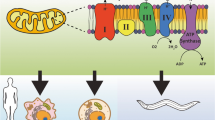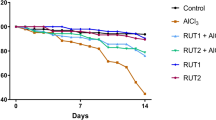Abstract
Alzheimer’s disease is an age-related neurodegenerative disease. Extracellular aggregation of amyloid beta is a well-known hallmark of Alzheimer’s disease and believed to be critical for the development of Alzheimer’s disease. Lots of efforts have been put on finding an intervention alleviating amyloid beta toxicity. Electrolyzed-reduced water is generated near cathode by electrolysis of water and shown to have strong anti-oxidant and lifespan-extending activities in C. elegans. Here, we examined the effect of electrolyzed-reduced water on amyloid beta toxicity and investigated underlying cellular mechanism involved. Worms grown in media prepared with electrolyzedreduced water showed delayed amyloid beta-induced paralysis and age-related decline in motility. DAF-16, a FOXO transcription factor modulating insulin/IGF-1-like signal, is required for the protection against amyloid beta toxicity. These findings indicate that electrolyzed-reduced water can prevent amyloid beta toxicity via DAF-16 and suggest that electrolyzedreduced water could be utilized for the development of therapeutic intervention to Alzheimer’s disease.
Similar content being viewed by others
References
Ross, C. A. & Poirier, M. A. Protein aggregation and neurodegenerative disease. Nat. Med. 10, Suppl:S10–17 (2004).
Kayed, R. et al. Common structure of soluble amyloid oligomers implies common mechanism of pathogenesis. Science 300, 486–489 (2003).
Kang, J. et al. The precursor of Alzheimer’s disease amyloid A4 protein resembles a cell-surface receptor. Nature 325, 733–736 (1987).
Shah, S. & Reichman, W. E. Treatment of Alzheimer’s disease across the spectrum of severity. Clin. Interv. Aging. 1, 131–142 (2006).
Link, C. D. Expression of human beta-amyloid peptide in transgenic Caenorhabditis elegans. Proc. Natl. Acad. Sci. U.S.A. 92, 9368–9372 (1995).
Hassan, W. M., Merin, D. A., Fonte, V. & Link, C. D. AIP-1 ameliorates beta-amyloid peptide toxicity in a Caenorhabditis elegans Alzheimer’s disease model. Hum. Mol. Genet. 18, 2739–2747 (2009).
Diomede, L. et al. Tetracycline and its analogues protect Caenorhabditis elegans from beta amyloid-induced toxicity by targeting oligomers. Neurobiol. Dis. 40, 424–431 (2010).
Cohen, E. et al. Opposing activities protect against ageonset proteotoxicity. Science 313, 1604–1610 (2006).
Park, C. M., Hung, Y. C., Lin, C. S. & Brackett, R. E. Efficacy of electrolyzed water in inactivating Salmonella enteritidis and Listeria monocytogenes on shell eggs. J. Food Prot. 68, 986–990 (2005).
Shirahata, S. et al. Electrolyzed-reduced water scavenges active oxygen species and protects DNA from oxidative damage. Biochem. Biophys. Res. Commun. 234, 269–274 (1997).
Lee, M. Y. et al. Electrolyzed-reduced water protects against oxidative damage to DNA, RNA, and protein. Appl. Biochem. Biotechnol. 135, 133–144 (2006).
Park, S. K. et al. Electrolyzed-reduced water confers increased resistance to environmental stresses. Mol. Cell Toxicol. 8, 241–247 (2012).
Park, S. K. & Park, S. K. Electrolyzed-reduced water increases resistance to oxidative stress, fertility, and lifespan via insulin/IGF-1-like signal in C. elegans. Biol. Res. 46, 147–152 (2013).
Yan, H. et al. Extension of the lifespan of Caenorhabditis elegans by the use of electrolyzed reduced water. Biosci. Biotechnol. Biochem. 74, 2011–2015 (2010).
Yan, H. et al. Mechanism of the lifespan extension of Caenorhabditis elegans by electrolyzed reduced water—participation of Pt nanoparticles. Biosci. Biotechnol. Biochem. 75, 1295–1299 (2011).
Link, C. D. C. elegans models of age-associated neurodegenerative diseases: lessons from transgenic worm models of Alzheimer’s disease. Exp. Gerontol. 41, 1007–1013 (2006).
Beckman, K. B. & Ames, B. N. The free radical theory of aging matures. Physiol. Rev. 78, 547–581 (1998).
Keowkase, R., Aboukhatwa, M. & Luo, Y. Fluoxetine protects against amyloid-beta toxicity, in part via daf-16 mediated cell signaling pathway, in Caenorhabditis elegans. Neuropharmacology 59, 358–365 (2010).
Rossi, P. et al. Human skeletal muscle aging and the oxidative system: cellular events. Curr. Aging Sci. 1, 182–191 (2008).
Lin, K., Dorman, J. B., Rodan, A. & Kenyon, C. daf-16: An HNF-3/forkhead family member that can function to double the life-span of Caenorhabditis elegans. Science 278, 1319–1322 (1997).
Cohen, E. & Dillin, A. The insulin paradox: aging, proteotoxicity and neurodegeneration. Nat. Rev. Neurosci. 9, 759–767 (2008).
Guarente, L. & Kenyon, C. Genetic pathways that regulate ageing in model organisms. Nature 408, 255–262 (2000).
Lee, R. Y., Hench, J. & Ruvkun, G. Regulation of C. elegans DAF-16 and its human ortholog FKHRL1 by the daf-2 insulin-like signaling pathway. Curr. Biol. 11, 1950–1957 (2001).
Kamath, R. S. et al. Systematic functional analysis of the Caenorhabditis elegans genome using RNAi. Nature 421, 231–237 (2003).
Author information
Authors and Affiliations
Corresponding author
Rights and permissions
About this article
Cite this article
Lee, JS., Park, SK. & Park, SK. Electrolyzed-reduced water mitigates amyloid beta toxicity via DAF-16 in C. elegans . Toxicol. Environ. Health Sci. 8, 56–61 (2016). https://doi.org/10.1007/s13530-016-0261-5
Received:
Revised:
Accepted:
Published:
Issue Date:
DOI: https://doi.org/10.1007/s13530-016-0261-5




